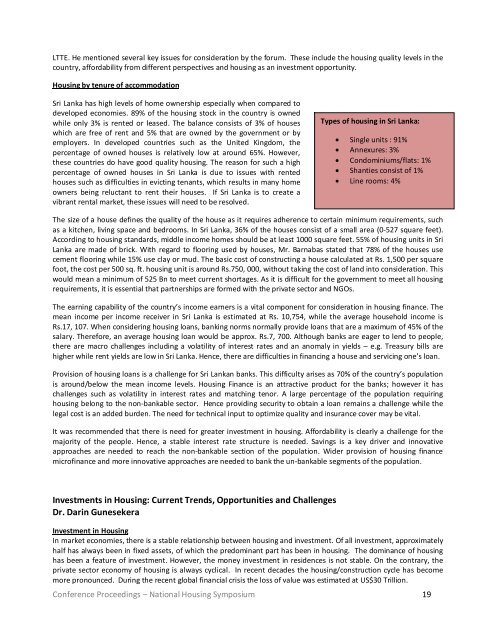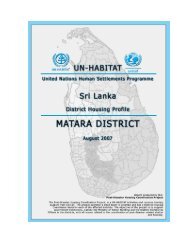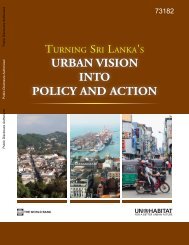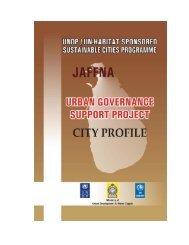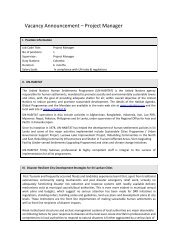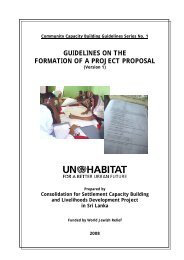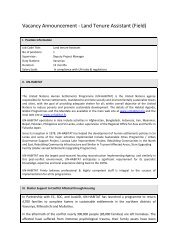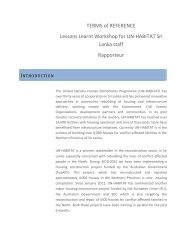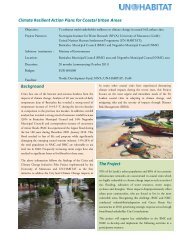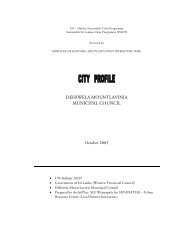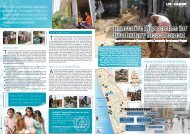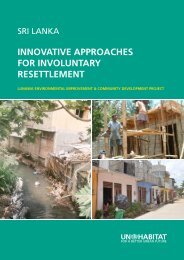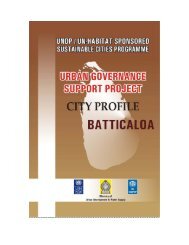Conference Proceedings : âJANASEVANAâ National ... - UN HABITAT
Conference Proceedings : âJANASEVANAâ National ... - UN HABITAT
Conference Proceedings : âJANASEVANAâ National ... - UN HABITAT
Create successful ePaper yourself
Turn your PDF publications into a flip-book with our unique Google optimized e-Paper software.
LTTE. He mentioned several key issues for consideration by the forum. These include the housing quality levels in the<br />
country, affordability from different perspectives and housing as an investment opportunity.<br />
Housing by tenure of accommodation<br />
Sri Lanka has high levels of home ownership especially when compared to<br />
developed economies. 89% of the housing stock in the country is owned<br />
while only 3% is rented or leased. The balance consists of 3% of houses<br />
which are free of rent and 5% that are owned by the government or by<br />
employers. In developed countries such as the United Kingdom, the<br />
percentage of owned houses is relatively low at around 65%. However,<br />
these countries do have good quality housing. The reason for such a high<br />
percentage of owned houses in Sri Lanka is due to issues with rented<br />
houses such as difficulties in evicting tenants, which results in many home<br />
owners being reluctant to rent their houses. If Sri Lanka is to create a<br />
vibrant rental market, these issues will need to be resolved.<br />
Types of housing in Sri Lanka:<br />
• Single units : 91%<br />
• Annexures: 3%<br />
• Condominiums/flats: 1%<br />
• Shanties consist of 1%<br />
• Line rooms: 4%<br />
The size of a house defines the quality of the house as it requires adherence to certain minimum requirements, such<br />
as a kitchen, living space and bedrooms. In Sri Lanka, 36% of the houses consist of a small area (0‐527 square feet).<br />
According to housing standards, middle income homes should be at least 1000 square feet. 55% of housing units in Sri<br />
Lanka are made of brick. With regard to flooring used by houses, Mr. Barnabas stated that 78% of the houses use<br />
cement flooring while 15% use clay or mud. The basic cost of constructing a house calculated at Rs. 1,500 per square<br />
foot, the cost per 500 sq. ft. housing unit is around Rs.750, 000, without taking the cost of land into consideration. This<br />
would mean a minimum of 525 Bn to meet current shortages. As it is difficult for the government to meet all housing<br />
requirements, it is essential that partnerships are formed with the private sector and NGOs.<br />
The earning capability of the country’s income earners is a vital component for consideration in housing finance. The<br />
mean income per income receiver in Sri Lanka is estimated at Rs. 10,754, while the average household income is<br />
Rs.17, 107. When considering housing loans, banking norms normally provide loans that are a maximum of 45% of the<br />
salary. Therefore, an average housing loan would be approx. Rs.7, 700. Although banks are eager to lend to people,<br />
there are macro challenges including a volatility of interest rates and an anomaly in yields – e.g. Treasury bills are<br />
higher while rent yields are low in Sri Lanka. Hence, there are difficulties in financing a house and servicing one’s loan.<br />
Provision of housing loans is a challenge for Sri Lankan banks. This difficulty arises as 70% of the country’s population<br />
is around/below the mean income levels. Housing Finance is an attractive product for the banks; however it has<br />
challenges such as volatility in interest rates and matching tenor. A large percentage of the population requiring<br />
housing belong to the non‐bankable sector. Hence providing security to obtain a loan remains a challenge while the<br />
legal cost is an added burden. The need for technical input to optimize quality and insurance cover may be vital.<br />
It was recommended that there is need for greater investment in housing. Affordability is clearly a challenge for the<br />
majority of the people. Hence, a stable interest rate structure is needed. Savings is a key driver and innovative<br />
approaches are needed to reach the non‐bankable section of the population. Wider provision of housing finance<br />
microfinance and more innovative approaches are needed to bank the un‐bankable segments of the population.<br />
Investments in Housing: Current Trends, Opportunities and Challenges<br />
Dr. Darin Gunesekera<br />
Investment in Housing<br />
In market economies, there is a stable relationship between housing and investment. Of all investment, approximately<br />
half has always been in fixed assets, of which the predominant part has been in housing. The dominance of housing<br />
has been a feature of investment. However, the money investment in residences is not stable. On the contrary, the<br />
private sector economy of housing is always cyclical. In recent decades the housing/construction cycle has become<br />
more pronounced. During the recent global financial crisis the loss of value was estimated at US$30 Trillion.<br />
<strong>Conference</strong> <strong>Proceedings</strong> – <strong>National</strong> Housing Symposium 19


